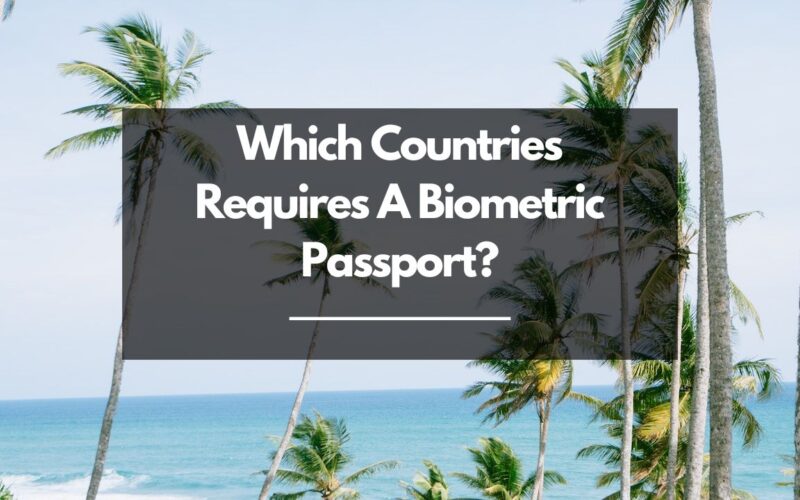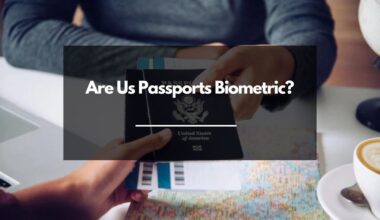As an Amazon Associate, I earn a small commission from qualifying purchases. Learn more about this.
The rise of biometric passports has undeniably altered the landscape of international travel. With an increasing number of countries requiring these documents, understanding which ones do is vital for any traveler.
In this post, we’ll cover the list of countries that require Biometric passports as prerequisites.
What Exactly is a Biometric Passport?
A biometric passport sometimes referred to as an e-passport, takes the traditional paper passport with technology.
It still has your usual passport information – your name, date of birth, nationality, and a passport photo, depending on your country’s passport format.
But what sets it apart from the traditional passports is the embedded electronic microprocessor chip it comes with.
Now, don’t worry, this isn’t some sci-fi movie stuff! This chip simply contains the biometric data that verifies the passport holder’s identity. It could include details like fingerprints, facial recognition data, and iris scans.
The idea behind these passports is quite straightforward – they’re designed to add an extra layer of security and make it harder for people to commit passport fraud.
They’re also there to help speed up the process at the immigration counter (a definite win if you’re keen to dodge those long lines!).
Which Countries Requires A Biometric Passport?
If you’re planning to travel abroad, it’s important to know whether you need a biometric passport. These are becoming increasingly common in recent years, with a total record of 164 countries implemented so far.
Obviously for good reasons such as security, however, could also come with other disadvantages like a hard time moving through countries, just like you may be having now.
Nevertheless, let’s get to this list…
One country that requires a biometric passport is the United States.
Since April 1, 2016, all travelers entering the US under the Visa Waiver Program must possess an e-passport.
This is also similar, moving across the Atlantic.
Most European countries have also adopted biometric passport requirements.
For instance, the Schengen Area, which includes 26 European countries like Germany, France, Italy, and Spain, mandates that travelers possess an e-passport.
Heading to the Far East, countries like Japan and South Korea also require biometric passports. Japan implemented this requirement to enhance its immigration security, while South Korea made it mandatory for foreigners entering the country for long-term stays.
But keep in mind most Asian countries, specifically India still don’t require biometrics and even worse, don’t issue them. For detailed info, you can check our list of non-biometric passport countries.
Australia, Canada, New Zealand, and the United Kingdom, are also other countries that have jumped on the biometric passport bandwagon.
Each of these countries has its own specific requirements, so it’s essential to check the latest information from their respective immigration authorities.
Note that this list is not exhaustive, and passport requirements can change over time.
Always check with the embassy or consulate of your destination country to ensure you have the correct documentation before embarking on your journey.
Read Also: Biometric Passport Vs Machine-readable Passports
What Are The Requirements To Obtain A Biometric Passport?
It’s important to have a clear understanding that non-biometric passports aren’t explicitly useless. If you have them, they could still be used, unless you intend to move to a country that doesn’t support them.
With that in mind, let’s move on.
First off, let’s be clear that obtaining a biometric passport isn’t really all that different from getting a traditional passport.
You’ll need to provide the usual evidence of citizenship, such as a birth certificate or previous passport, along with proof of identity, like a driver’s license or a government-issued ID card. And yes, you’ll still need to provide those flattering passport photos!
Here’s where things get a little more high-tech. To obtain a biometric passport, you’ll also need to provide biometric data. This can seem a bit futuristic, but it’s really not as daunting as it sounds.
Depending on your country, this could involve having your fingerprints taken, having your photo captured digitally for facial recognition, or even providing an iris scan.
This process is designed to tie your unique physical characteristics to your passport, adding an extra layer of security.
And don’t worry, this data is securely stored and used strictly for identification purposes. It’s a bit like your own personal security guard, making sure that your passport is just that – yours.
Once all your documents and biometric data are in order, you’ll need to fill out the necessary application form and pay the application fee. Then, it’s just a matter of waiting for your shiny new biometric passport to arrive!
Wrapping up
The biometric passport has transformed the face of international travel, increasing both security and efficiency. With an ever-growing list of countries requiring these passports, it’s important for travelers to stay up-to-date.







